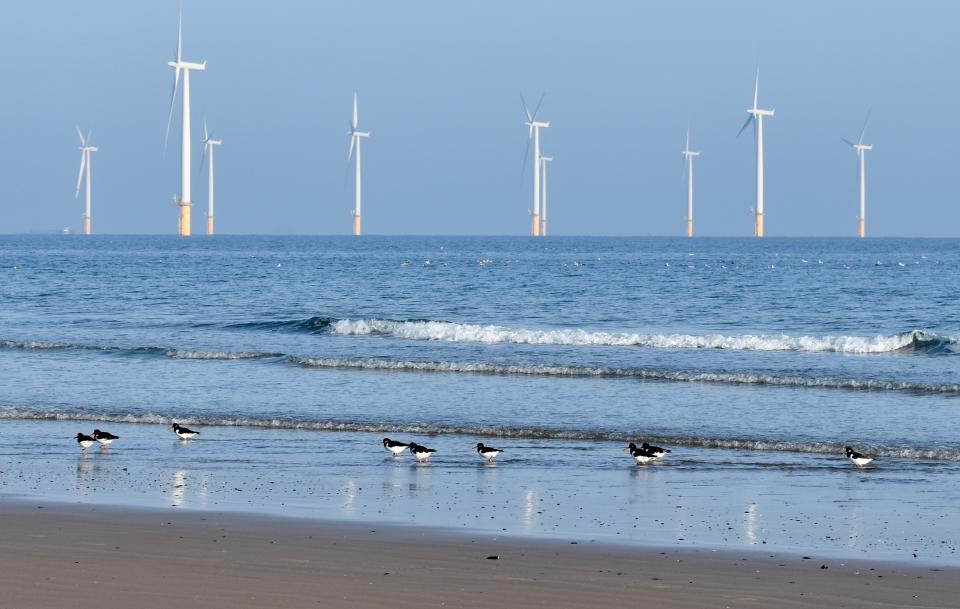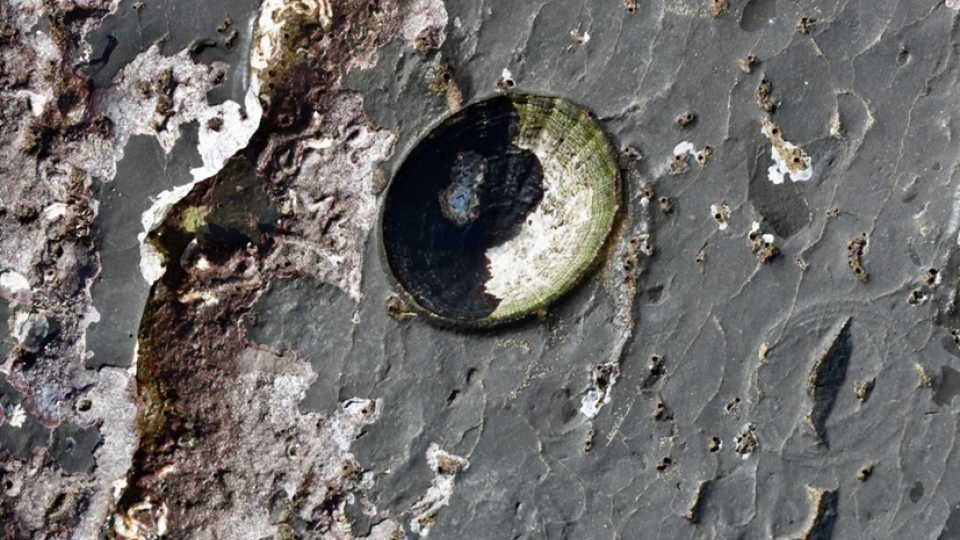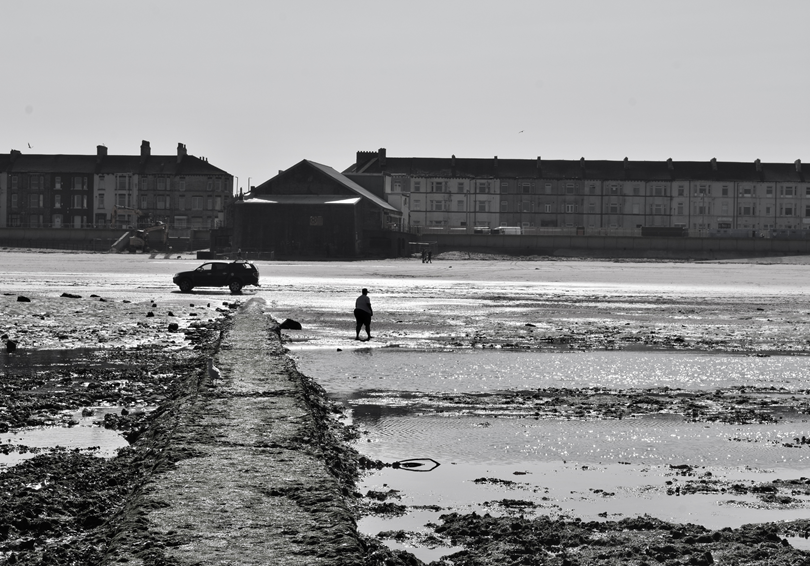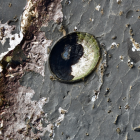I lean on the wall of the concrete promenade and take in a regiment of 27 wind turbines a kilometre out to sea. Unblinking, they stare back at the shoreline of Redcar on England’s northeast coast, a horizon of industry and faded seaside splendour. The turbines are constructed islands with concrete feet protruding deep into the seabed, islands standing where it was once just sea. A stew of oystercatchers peck at a thin band of damp sand. High tide was an hour ago. Redcar’s Regent Cinema protrudes from the promenade into the beach—the high tide fell just short of its concrete foundations.

The tide is in, but it has just turned and is starting to ebb. Oystercatchers. Wind turbines.
The tide is in, but it has just turned and is starting to ebb. Oystercatchers. Wind turbines.
Photograph by Suzi Richer, 21 September 2020.
 This work is licensed under a Creative Commons Attribution 4.0 International License.
This work is licensed under a Creative Commons Attribution 4.0 International License.
I am here because of the Regent Cinema. It is being pulled down and a new one constructed in its place. As part of the rebuilding, planning regulations require that the archaeology is assessed. In this case, the archaeology is a fragmenting prehistoric submerged forest preserved in a layer of peat below the beach, and I am the environmental archaeologist here to assess it.
Standing on the present-day beach in the Mesolithic—seven thousand years ago—sea levels were lower and Great Britain was still connected to the continent. The sea was some distance away, shaded out and muffled by birch, oak, alder, small-leaved lime, hazel, and pine trees, and by pools of fresh water. Rather than gazing at oystercatchers, I would have been watching smew, shelduck, and heron.
Rising seas from the melting glaciers of the last ice age had effects inland. Sea levels rose in surges that would subside, each pulse causing ground water to rise. A thousand years later, during the Neolithic, the forest began to drown as ripples of the rising seas reached the roots of the trees. They slowly suffocated. The sea was encroaching on the land.
Today, the sampling has finished and the sun is shining. It’s lunchtime, but I don’t want to head home yet. The spring tide has ebbed and Coatham Rocks, a band of Jurassic mudstones, have emerged at the low tide line. Land has appeared from the sea. A Victorian sewage pipe joins them to the beach, and people walk along it like a bridge, as a way onto the rocks.
Five people are bending and collecting shellfish into buckets, bags, and trugs. I ask one woman what she is gathering. Her whole face smiles at me, she’s collecting just for herself, her husband “does not like.” Pointing southwards, she tells me she has lived here for 10 years, she’s from Thailand. It strikes me that she has moved from one coastal edgeland to another. Mussels, limpets, and periwinkles connect the continents.
The top of the submerged peat dates to the Bronze Age, about four thousand years ago. What has happened between then and now? The rising seas may have preserved the peats initially, but they have been (and are still) gnawed at by the sea. The sea is not the only thief, some of it was also taken by people.

Limpet. Mudstone.
Limpet. Mudstone.
Photograph by Suzi Richer, 2020.
 This work is licensed under a Creative Commons Attribution 4.0 International License.
This work is licensed under a Creative Commons Attribution 4.0 International License.
In the late nineteenth century, storms unveiled the submerged forest and peat and people made the most of it:
… people of the town have cut up and carted away some hundreds of loads of the wood, which, when dried, burns readily …
—The Northern Echo, 27 February 1873
Also in 1873, construction began on a 610-meter pier, a structure of iron and wood that went from the shore out to Coatham Rocks. This was land that was suspended above the sea. But the storms did not stop. In December 1874, two vessels, the Griffin and the Corrymbus catastrophically collided with it. Work was finally completed in 1875, but only after the pier had been shortened to 550 meters. Twenty-four years later, following more storms and catastrophic collisions, it was closed and allowed to disintegrate. The stub that is the Regent Cinema is all that remains, the sea has reclaimed the suspended land.
Imagine the letter H. One of the parallel upright lines is the shore, and the other is Coatham Rocks, where I’m standing. The sewage pipe is the bar that joins them and, more importantly, is my passage back to the land. The tide has turned, and my upright line has become dashed as sea water imperceptibly floods in. The shellfish collectors have slowly migrated back to the shore. My heart pounds as I wade back to the safety of the sewage pipe.

The tide is out, but it has turned and is starting to flood. The sewage pipe connects the beach to the rocks. The Regent Cinema is beyond the pick-up truck.
The tide is out, but it has turned and is starting to flood. The sewage pipe connects the beach to the rocks. The Regent Cinema is beyond the pick-up truck.
Photograph by Suzi Richer, 2020.
 This work is licensed under a Creative Commons Attribution 4.0 International License.
This work is licensed under a Creative Commons Attribution 4.0 International License.
The wind turbines come alive with the turning of the tide; their solidity gives them an air of permanence. But the sea and land shift regardless of who (or what) is here; they have a reciprocal relationship—a negative correlation. I’m unsure what these cycles of time, land, and sea will have in store for the wind turbines, or for us, but I do know that each exposure of the submerged forest is slowly eroding the ancient peat and tree stumps.
Through our cumulative actions the world has warmed up, causing an increase in storms, they act as the trigger that renders the submerged forest and peats visible. With storminess stepping up, the destruction of the submerged forest is imminent. The sea claws at the submerged land. For better or worse, that clawing is a blend of the natural world with our past and present ways—an alloy of the Anthropocene.
Acknowledgments
Many thanks to the anonymous reviewers’ comments, all of which were extremely welcome. Thanks to Alex Morgan for comments on a previous draft and for proofreading; to Don O’Meara for the photograph of the remains of the submerged forest; and to BAM Construction for funding the author’s initial research at Redcar.
How to cite
Richer, Suzi. “Sea Where there Once was Land: Redcar, England.” Environment & Society Portal, Arcadia (Spring 2021), no. 18. Rachel Carson Center for Environment and Society. doi:10.5282/rcc/9303.
ISSN 2199-3408
Environment & Society Portal, Arcadia
 This work is licensed under a Creative Commons Attribution 4.0 International License.
This work is licensed under a Creative Commons Attribution 4.0 International License.
2021 Suzi Richer
This refers only to the text and does not include any image rights.
Please click on an image to view its individual rights status.
- “A Submerged Forest at Redcar.” The Northern Echo, 27 February 1873: 3.
- Askew, Tony. “The Old Piers of Redcar.” Cleveland Industrial Heritage 8 (2001): 2–4.
- Richer, Suzi. “Palaeoenvironmental Assessment Report, Redcar Cinema, Redcar and Cleveland.” Unpublished report for Richer Environmental 20/12, 2020.
- Sherlock, Stephen. “A Submerged Forest on the Foreshore at Redcar, NZ 60302570.” Yorkshire Archaeological Journal 91, no. 1 (2019): 162–66.
- Tomek, Teresa, and Witold Gumiñski. “Bird Remains from the Mesolithic and Neolithic Site Dudka, Masuria, NE Poland.” Acta Zoologica Cracoviensia 46, no. 1 (2003): 9–18.
- Waughman, Mags. Archaeology and Environment of Submerged Landscapes in Hartlepool Bay, England. Vol. 2. Hartlepool: Tees Archaeology, 2005.









